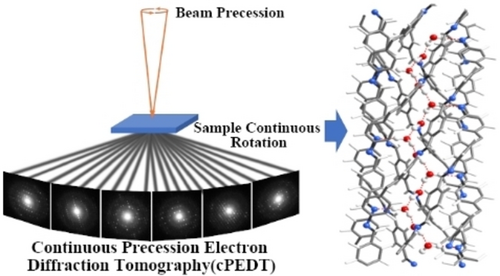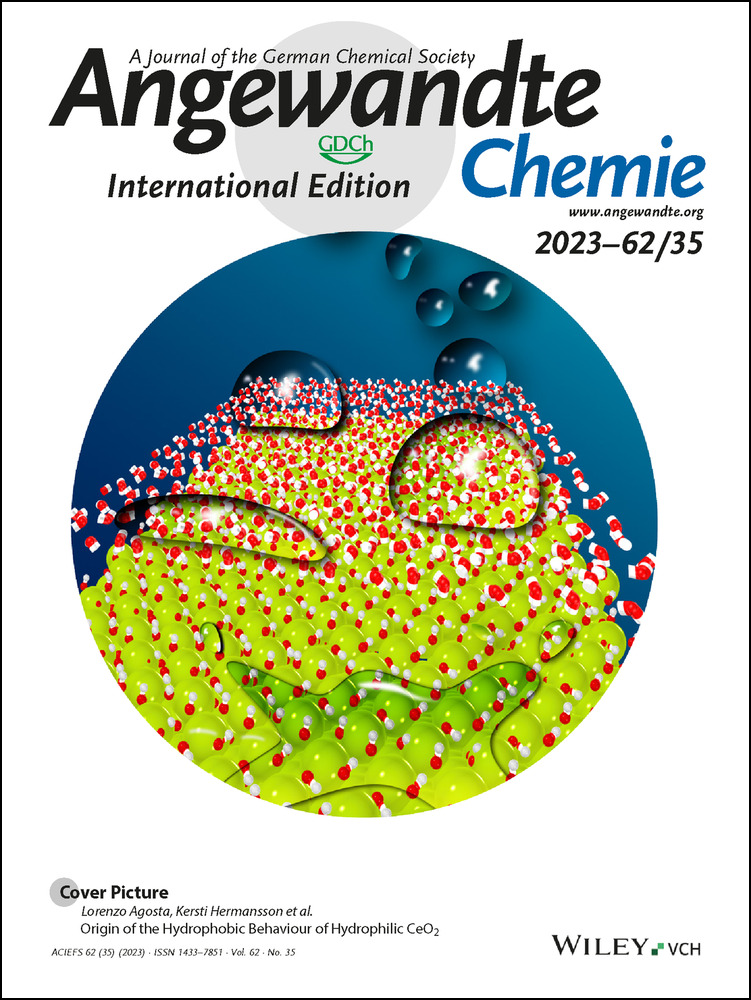Locating Hydrogen Positions for COF-300 by Cryo-3D Electron Diffraction
Wenjia Sun
College of Chemistry and Molecular Engineering, Beijing National Laboratory for Molecular Sciences, Peking University, Beijing, 100871 P.R. China
These authors contributed equally to this work.
Search for more papers by this authorPohua Chen
College of Chemistry and Molecular Engineering, Beijing National Laboratory for Molecular Sciences, Peking University, Beijing, 100871 P.R. China
These authors contributed equally to this work.
Search for more papers by this authorMingxuan Zhang
College of Chemistry and Molecular Engineering, Beijing National Laboratory for Molecular Sciences, Peking University, Beijing, 100871 P.R. China
Search for more papers by this authorJian-Xin Ma
College of Chemistry and Molecular Engineering, Beijing National Laboratory for Molecular Sciences, Peking University, Beijing, 100871 P.R. China
Search for more papers by this authorCorresponding Author
Prof. Dr. Junliang Sun
College of Chemistry and Molecular Engineering, Beijing National Laboratory for Molecular Sciences, Peking University, Beijing, 100871 P.R. China
Search for more papers by this authorWenjia Sun
College of Chemistry and Molecular Engineering, Beijing National Laboratory for Molecular Sciences, Peking University, Beijing, 100871 P.R. China
These authors contributed equally to this work.
Search for more papers by this authorPohua Chen
College of Chemistry and Molecular Engineering, Beijing National Laboratory for Molecular Sciences, Peking University, Beijing, 100871 P.R. China
These authors contributed equally to this work.
Search for more papers by this authorMingxuan Zhang
College of Chemistry and Molecular Engineering, Beijing National Laboratory for Molecular Sciences, Peking University, Beijing, 100871 P.R. China
Search for more papers by this authorJian-Xin Ma
College of Chemistry and Molecular Engineering, Beijing National Laboratory for Molecular Sciences, Peking University, Beijing, 100871 P.R. China
Search for more papers by this authorCorresponding Author
Prof. Dr. Junliang Sun
College of Chemistry and Molecular Engineering, Beijing National Laboratory for Molecular Sciences, Peking University, Beijing, 100871 P.R. China
Search for more papers by this authorGraphical Abstract
Abstract
Covalent organic frameworks (COFs) have wide-ranging applications, and their host–guest interactions play an essential role in the achievement of COF functions. To investigate these host–guest interactions, it is necessary to locate all atoms, especially hydrogen atoms. However, it is difficult to determine the hydrogen atomic positions in COFs because of the complexities in synthesizing high-quality large single crystals. Three-dimensional electron diffraction (3D ED) has unique advantages for the structural determination of nanocrystals and identification of light atoms. In this study, it was demonstrated for the first time that the hydrogen atoms of a COF, not only on the framework but also on the guest molecule, can be located by 3D ED using continuous precession electron diffraction tomography (cPEDT) under cryogenic conditions. The host–guest interactions were clarified with the location of the hydrogen atoms. These findings provide novel insights into the investigation of COFs.
Conflict of interest
The authors declare no conflict of interest.
Open Research
Data Availability Statement
The data that support the findings of this study are available from the corresponding author upon reasonable request.
Supporting Information
As a service to our authors and readers, this journal provides supporting information supplied by the authors. Such materials are peer reviewed and may be re-organized for online delivery, but are not copy-edited or typeset. Technical support issues arising from supporting information (other than missing files) should be addressed to the authors.
| Filename | Description |
|---|---|
| anie202305985-sup-0001-COF-300-C2H5OH-dyn.cif14.2 MB | Supporting Information |
| anie202305985-sup-0001-COF-300-C2H5OH-kn.cif169.8 KB | Supporting Information |
| anie202305985-sup-0001-COF-300-CH3OH-dyn.cif10.9 MB | Supporting Information |
| anie202305985-sup-0001-COF-300-CH3OH-kn.cif169.5 KB | Supporting Information |
| anie202305985-sup-0001-COF-300-H2O-dyn.cif22.8 MB | Supporting Information |
| anie202305985-sup-0001-COF-300-H2O-kn.cif129.2 KB | Supporting Information |
| anie202305985-sup-0001-COF-300-V-dyn.cif21.3 MB | Supporting Information |
| anie202305985-sup-0001-COF-300-V-kn.cif157.6 KB | Supporting Information |
| anie202305985-sup-0001-misc_information.pdf4.2 MB | Supporting Information |
Please note: The publisher is not responsible for the content or functionality of any supporting information supplied by the authors. Any queries (other than missing content) should be directed to the corresponding author for the article.
References
- 1M. Dincă, J. R. Long, Chem. Rev. 2020, 120, 8037–8038.
- 2Q. Fang, S. Gu, J. Zheng, Z. Zhuang, S. Qiu, Y. Yan, Angew. Chem. Int. Ed. 2014, 53, 2878–2882.
- 3S. Yuan, X. Li, J. Zhu, G. Zhang, P. Van Puyvelde, B. Van der Bruggen, Chem. Soc. Rev. 2019, 48, 2665–2681.
- 4Y. Zeng, R. Zou, Y. Zhao, Adv. Mater. 2016, 28, 2855–2873.
- 5L. Cao, H. Wu, Y. Cao, C. Fan, R. Zhao, X. He, P. Yang, B. Shi, X. You, Z. Jiang, Adv. Mater. 2020, 32, 2005565.
- 6H. L. Nguyen, N. Hanikel, S. J. Lyle, C. Zhu, D. M. Proserpio, O. M. Yaghi, J. Am. Chem. Soc. 2020, 142, 2218–2221.
- 7
- 7aR. Simancas, D. Dari, N. Velamazán, M. T. Navarro, A. Cantín, J. L. Jordá, G. Sastre, A. Corma, F. Rey, Science 2010, 330, 1219–1222;
- 7bX. Han, H. G. Godfrey, L. Briggs, A. J. Davies, Y. Cheng, L. L. Daemen, A. M. Sheveleva, F. Tuna, E. J. McInnes, J. Sun, Nat. Mater. 2018, 17, 691–696;
- 7cX. Liu, J. Li, B. Gui, G. Lin, Q. Fu, S. Yin, X. Liu, J. Sun, C. Wang, J. Am. Chem. Soc. 2021, 143, 2123–2129;
- 7dA. Schneemann, V. Bon, I. Schwedler, I. Senkovska, S. Kaskel, R. A. Fischer, Chem. Soc. Rev. 2014, 43, 6062–6096;
- 7eL. Liu, Y. Hu, S. Huang, Y. Jin, J. Cui, W. Gong, W. Zhang, Chem. Sci. 2021, 12, 13316–13320.
- 8N. Hanikel, X. Pei, S. Chheda, H. Lyu, W. Jeong, J. Sauer, L. Gagliardi, O. M. Yaghi, Science 2021, 374, 454–459.
- 9D.-W. Lim, H. Kitagawa, Chem. Rev. 2020, 120, 8416–8467.
- 10T. Ma, E. A. Kapustin, S. X. Yin, L. Liang, Z. Zhou, J. Niu, L.-H. Li, Y. Wang, J. Su, J. Li, X. Wang, W. D. Wang, W. Wang, J. Sun, O. M. Yaghi, Science 2018, 361, 48–52.
- 11M. Woińska, S. Grabowsky, P. M. Dominiak, K. Woźniak, D. Jayatilaka, Sci. Adv. 2016, 2, e1600192.
- 12K. K. Jha, F. Kleemiss, M. L. Chodkiewicz, P. M. Dominiak, J. Appl. Crystallogr. 2023, 56, 116–127.
- 13C. Baerlocher, F. Gramm, L. Massüger, L. B. McCusker, Z. He, S. Hovmöller, X. Zou, Science 2007, 315, 1113–1116.
- 14
- 14aT. Steiner, I. Majerz, C. C. Wilson, Angew. Chem. Int. Ed. 2001, 40, 2651–2654;
10.1002/1521-3773(20010716)40:14<2651::AID-ANIE2651>3.0.CO;2-2 CAS PubMed Web of Science® Google Scholar
- 14bM. T. Weller, P. F. Henry, V. P. Ting, C. C. Wilson, Chem. Commun. 2009, 2973–2989.
- 15
- 15aM. Gemmi, E. Mugnaioli, T. E. Gorelik, U. Kolb, L. Palatinus, P. Boullay, S. Hovmöller, J. P. Abrahams, ACS Cent. Sci. 2019, 5, 1315–1329;
- 15bY. Xie, J. Li, C. Lin, B. Gui, C. Ji, D. Yuan, J. Sun, C. Wang, J. Am. Chem. Soc. 2021, 143, 7279–7284;
- 15cZ. Huang, T. Willhammar, X. Zou, Chem. Sci. 2021, 12, 1206–1219.
- 16Y.-B. Zhang, J. Su, H. Furukawa, Y. Yun, F. Gándara, A. Duong, X. Zou, O. M. Yaghi, J. Am. Chem. Soc. 2013, 135, 16336–16339.
- 17C. Gao, J. Li, S. Yin, G. Lin, T. Ma, Y. Meng, J. Sun, C. Wang, Angew. Chem. Int. Ed. 2019, 58, 9770–9775.
- 18T. Sun, L. Wei, Y. Chen, Y. Ma, Y.-B. Zhang, J. Am. Chem. Soc. 2019, 141, 10962–10966.
- 19M. T. Clabbers, T. Gruene, E. van Genderen, J. P. Abrahams, Acta Crystallogr. Sect. A 2019, 75, 82–93.
- 20
- 20aL. Palatinus, P. Brázda, P. Boullay, O. Perez, M. Klementová, S. Petit, V. Eigner, M. Zaarour, S. Mintova, Science 2017, 355, 166–169;
- 20bG. Steciuk, J. Majzlan, J. Plášil, IUCrJ 2021, 8, 116–123;
- 20cP. Klar, Y. Krysiak, H. Xu, G. Steciuk, J. Cho, X. Zou, L. Palatinus, Nat. Chem. 2023, 15, 848–855.
- 21Y. Luo, M. T. Clabbers, J. Qiao, Z. Yuan, W. Yang, X. Zou, J. Am. Chem. Soc. 2022, 144, 10817–10824.
- 22Y. Shen, W. Sun, Y. Liu, Z. Zhou, J. Sun, Sci. China Mater. 2022, 65, 1417–1420.
- 23M. Ge, T. Yang, H. Xu, X. Zou, Z. Huang, J. Am. Chem. Soc. 2022, 144, 15165–15174.
- 24T. Ma, L. Wei, L. Liang, S. Yin, L. Xu, J. Niu, H. Xue, X. Wang, J. Sun, Y.-B. Zhang, Nat. Commun. 2020, 11, 6128.
- 25
- 25aZ. Wang, Z. Si, D. Cai, G. L. S. Li, P. Qin, J. Membr. Sci. 2020, 615, 118466;
- 25bP. Jin, X. Niu, F. Zhang, K. Dong, H. Dai, H. Zhang, W. Wang, H. Chen, X. Chen, ACS Appl. Mater. Interfaces 2020, 12, 20414–20422;
- 25cW. Gao, X. Sun, H. Niu, X. Song, K. Li, H. Gao, W. Zhang, J. Yu, M. Jia, Microporous Mesoporous Mater. 2015, 213, 59–67.
- 26L. Palatinus, G. Chapuis, J. Appl. Crystallogr. 2007, 40, 786–790.
- 27G. M. Sheldrick, Acta Crystallogr. Sect. A 2008, 64, 112–122.
- 28G. M. Sheldrick, Acta Crystallogr. Sect. C 2015, 71, 3–8.
- 29C. G. Jones, M. W. Martynowycz, J. Hattne, T. J. Fulton, B. M. Stoltz, J. A. Rodriguez, H. M. Nelson, T. Gonen, ACS Cent. Sci. 2018, 4, 1587–1592.
- 30G. M. Sheldrick, Acta Crystallogr. Sect. A 2015, 71, 3–8.
- 31Y. Chen, Z.-L. Shi, L. Wei, B. Zhou, J. Tan, H.-L. Zhou, Y.-B. Zhang, J. Am. Chem. Soc. 2019, 141, 3298–3303.
- 32P. Owston, Adv. Phys. 1958, 7, 171–188.
- 33Y. Gu, T. Kar, S. Scheiner, J. Am. Chem. Soc. 1999, 121, 9411–9422.
- 34
- 34aT. Steiner, Angew. Chem. Int. Ed. 2002, 41, 48–76;
- 34bG. A. Jeffrey, G. A. Jeffrey, An introduction to hydrogen bonding, Vol. 12, Oxford university press, New York, 1997.
- 35P. R. Spackman, M. J. Turner, J. J. McKinnon, S. K. Wolff, D. J. Grimwood, D. Jayatilaka, M. A. Spackman, J. Appl. Crystallogr. 2021, 54, 1006–1011.
- 36Deposition numbers 2271013 (for COF-300−V-dyn), 2271014 (for COF-300−V-kn), 2270953 (for COF-300−H2O-kn), 2270954 (for COF-300−H2O-dyn), 2270958 (for COF-300−CH3OH-kn), 2270959 (for COF-300−C2H5OH-kn), 2270960 (for COF-300−C2H5OH-dyn) and 2270961 (for COF-300−CH3OH-dyn) contain the supplementary crystallographic data for this paper. These data are provided free of charge by the joint Cambridge Crystallographic Data Centre and Fachinformationszentrum Karlsruhe Access Structures service.





